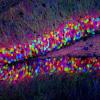
GPC (choline), Uridine, DHA
#2131
Posted 23 August 2013 - 08:45 PM
#2132
Posted 24 August 2013 - 06:55 AM
http://www.ncbi.nlm....pubmed/7109458/
Abstract
To assess the effects of streptozotocin-induced diabetes on the substrates utilized in the formation of glycoproteins, the pools of uridine 5'-diphosphoglucose (UDPG), uridine 5'-diphosphogalactose (UDP-GAL), uridine 5'-diphosphoglucuronic acid (UDPGA), and uridine 5'-diphospho N-acetyl galactosamine (UDPA-GAL) were measured in the renal cortex of control and over a 48-hr period in diabetic rats. In control rats these pools measured: UDPG, 256 +/- 23; UDP-GAL, 75 +/- 14; UDPGA, 147 +/- 16; UDPAG, 367 +/- 23; UDPG-GAL, 131 +/- 13 nmoles/mg DNA. In diabetic rats, except for UDP-GAL, all pools were increased 41 to 68%. The incorporation of radiolabeled orotate was increased in all pools, except UDP-GAL, in diabetic rats by 41 to 77% compared to control rats. The incorporation into UDPG and UDPAG was increased even after correction for the specific radioactivity of their immediate precursor, uridine 5'-triphosphate (UTP). Expansion of the UTP pool after orotate infusion was associated with an increase in the size of the UDPG and UDPAG pools in both control and diabetic rats. Depletion of the UTP pool after adenine infusion in controls was associated with a decrease in all pools. This study demonstrates that after the induction of diabetes there is a rapid increase in the bioavailability of substrates utilized in the synthesis of glycoproteins and glycosaminoglycans. It is theorized that this increase is necessary for the augmented synthesis of basement membrane-like material in the diabetic kidney.
PMID 7109458 [PubMed - indexed for MEDLINE]
Also:
http://www.ncbi.nlm..../pubmed/221781/
Effect of diabetes and fasting on the uridine triphosphate content and uridine kinase activity of rat cardiac and skeletal muscle.
AuthorsGertz BJ, et al. Show all Journal
Metabolism. 1979 Apr;28(4):358-62.
Affiliation
Abstract
The influence of diabetes and starvation on uracil nucleotide metabolism in muscle was studied. It was found that the uridine triphosphate (UTP) content of heart and diaphragm muscle was decreased in fasted and streptozotocin-diabetic rats and that insulin treatment of diabetic animals restored the UTP concentration to normal levels. The ATP content of heart tissue was not altered under these conditions. It was also demonstrated that hemidiaphragms from streptozotocin-diabetic rats synthesized less UTP from uridine in vitro than hemidiaphragms from normal animals. Uridine kinase activity of extracts of cardiac and skeletal muscle from fasted and diabetic rats was lower than the activity found in extracts from control animals. It was concluded that uracil nucleotide synthesis by the salvage pathway is decreased in experimental diabetes and fasting.
#2133
Posted 27 August 2013 - 07:21 PM
#2134
Posted 30 August 2013 - 06:27 PM
#2135
Posted 31 August 2013 - 09:17 AM
nobody ever stopped taking uridine?
<chuckle>
#2136
Posted 31 August 2013 - 09:29 AM
I stopped taking TAU for now. It did improve my cognition in some areas but ended up getting some side effects. Later gonna try UMP.nobody ever stopped taking uridine?
#2137
Posted 31 August 2013 - 02:06 PM
#2138
Posted 07 September 2013 - 11:33 AM
http://www.ncbi.nlm....les/PMC2578826/
Synapse Formation and Cognitive Brain Development: effect of docosahexaenoic (DHA) and other dietary constituents
OCT. 7, 2008
The brain is unusual among organs in that the rates of many of its characteristic enzymatic reactions are controlled by the local concentrations of their substrates, which also happen to be nutrients that cross the blood-brain barrier. Thus, for example, brain levels of tryptophan, tyrosine, or choline can control the rates at which neurons synthesize serotonin, dopamine, or acetylcholine, respectively. The rates at which brain cells produce membrane phospholipids like phosphatidylcholine (PC) are also under such control, both in adult animals and, especially, during early development. If pregnant rats are fed the three dietary constituents needed for PC synthesis - docosahexaenoic acid (DHA), uridine, and choline - starting 10 days before parturition and continuing for 20 days during nursing, brain levels of PC and of the other membrane phosphatides (per cell or per mg protein) are increased by 50% or more. In adult animals this treatment is also known to increase synaptic proteins (e.g. synapsin-l; syntaxin-3; GluR-l; PSD-95) but not ubiquitous proteins like beta-tubulin, and to increase (by 30% or more) the number of dendritic spines on hippocampal neurons. DHA currently is widely used, in human infants, to diminish the negative effects of prematurity on cognitive development. Moreover, DHA, uridine (as UMP), and choline are all found in mother's milk, and included in most infant formulas. It is proposed that these substances are part of a regulatory mechanism through which plasma composition influences brain development.
Keywords: omega-3 fatty acids, phosphatidylcholine, uridine, arachidonic acid, phosphatidylcholine
Omega-3 Fatty Acids and the Brain
The phospholipids in brain membranes contain many different fatty acids (c.f. ref. 1). However one such compound, the omega-3 polyunsaturated fatty acid docosahexaenoic acid (DHA), is both uniquely abundant among them (2) and particularly important in the development and maintenance of brain mechanisms underlying cognitive functions (3). Thus, cognitive development among breast-fed full-term infants, or in full-term or preterm infants given supplemental DHA, is described as being superior to that in infants consuming formula diets that lack DHA (4); and the consumption, by term infants of a formula supplemented with DHA (plus the omega-6 fatty acid arachidonic acid [AA]) during the first 17 weeks of life increased test scores on the Mental Development Index, assessed a year or more later (5). At the other end of life, DHA levels in plasma phosphatidylcholine (PC) are inversely correlated with the risk of developing dementia, as shown in aged participants (average: 76 years) enrolled in the Framingham Heart Study and followed for 9 years (6), and high intakes of fish or of DHA have been described by most investigators as protective against age-related cognitive decline and the risk of developing Alzheimer's Disease (7,8,9). DHA administration has also been found to produce dose-related improvements in cognitive functions in various experimental animals (c.f. ref. 10).
A number of hypotheses have been proposed to explain the beneficial effects of DHA consumption on brain functions and, particularly, cognition. These include, among others, changing the “fluidity” of neuronal membranes (11), and thereby alternating the activities of receptors, ion channels, G-proteins, and other proteins embedded in the membranes; being transformed to active metabolites (12) like “neuroprotectin D1” (10,17S-docosatriene) which reportedly suppresses A-beta-42 neurotoxicity (13) or to the prostaglandin-like F4-neuroprostanes (14); promoting neurogenesis by causing the differentiation of neuronal stem cells (15); activating syntaxin-3, a synaptic membrane protein that promotes neurite outgrowth (16); decreasing the AA content of brain phospholipids (17); or forming DHA-rich diacylglycerols which are preferentially utilized for synthesizing membrane phosphatides via the Kennedy Cycle (18).
Oral DHA has now also been shown to promote the synthesis of synaptic membranes, elevating the levels, per brain cell, of both the phosphatides and the specific pre- and post-synaptic proteins that characterize these membranes (19). DHA also increases the numbers of dendritic spines (20), and probably synapses, on hippocampal neurons, particularly on excitatory glutamatergic synapses. These effects, described below, can also be produced by eicosapentaenoic acid (EPA), another omega-3 fatty acid, but not by the omega-6 fatty acid arachidonic acid (AA) (21). They are considerably amplified if animals also receive two compounds that, with DHA, are present in mother's milk or infant formulas, i.e. uridine (19), a circulating pyrimidine which gives rise in brain to uridine triphosphate (UTP) and cytidine triphosphate (CTP) (22,23) and choline. It is thus possible that DHA affects cognition principally by promoting neurotransmission, and that it does so by increasing the numbers of certain synapses.
Effects of DHA on Brain during Early Development
If pregnant rats receive – during the ten days prior to parturition and for the initial twenty days of lactation - daily doses of DHA by gavage and supplemental uridine (as UMP) via their diets, brains of their offspring exhibit neurochemical changes similar to those described above in adult animals: DHA alone produces small (20-30%) increases in each of the major phosphatides, while giving DHA plus UMP produces greater (50% or more) increases, per cell and per brain. Largest changes occur in phosphatidylinositol, the precursor of the second messengers inositol triphosphate and diacylglycerol, its levels more than doubling in animals whose mothers receive DHA plus UMP. Most of these increases result from supplementation during the postnatal period, since brains of offspring obtained and assayed at birth did not exhibit significant changes. Treating the mothers with DHA plus UMP also elevates brain levels of pre- and post-synaptic proteins (e.g., PSD95; synapsin-1; the metabotropic GluR-1 receptor; syntaxin-3) in the infant rat, and the numbers of hippocampal dendritic spines. Hence this treatment may affect the number of brain synapses formed during development. No data are available at present on how long these increases persist, nor on their possible functional or behavioral consequences. However it should be noted that, in other studies, brains of rats whose mothers received supplemental choline during embryonic days 11-17 exhibited, postnatally (days 15-34), increased expression of genes for brain proteins thought to be related to cognitive function (e.g., calcium-calmodulin-dependent protein kinase [CaMK]; insulin-like growth factor), and such animals have been shown to manifest lifelong improvements in memory performance (41).
Human breast milk contains both DHA and arachidonic acid, the levels of which depend on the mother's diet: Among women consuming cod liver oil, the DHA/AA ratio is about 4:1, while among those who instead consume corn oil, this ratio is only 1:1. Breast milk also contains choline and uridine, as such and as UMP, UDP-glucose, and UTP, but also as cytidine, CMP,CTP, - all converted to uridine in the human liver (31) - and as RNA, which is readily broken down to uridine in the newborn's intestine (42,43) Commercial infant formulas also include these compounds, however their uridine contents are not, in general, as great as those a breast-fed infant would obtain from the uridine- or cytidine-containing compounds (including RNA) in mothers' milk. Whether or not providing additional DHA uridine or choline would improve brain development in normal infants, or facilitate recovery from neonatal brain injury remains to be determined.
DHA and Uridine Increase Phosphatide and Synaptic Protein Levels in Gerbil and Rat Brain
Three circulating compounds are essential precursors in the synthesis of phosphatidylcholine (PC), the major phosphatide in neuronal membranes (1), as well as of phosphatidylethanolamine (PE), and, indirectly, by base exchange, of phosphatidylserine (PS): DHA; a uridine source; and a choline source. Each of these precursors is able to limit the overall rate of PC synthesis because its levels in brain are insufficient to saturate the brain enzymes that catalyze its utilization; moreover, the effects of giving all three together tend to be substantially greater than the summed effects of giving each alone. Uridine may also promote membrane synthesis via UTP, which activates P2Y receptors that promote neurite outgrowth (24), and DHA's effects may, as described above, also involve additional sites of action besides neuronal phosphatide synthesis. Perhaps surprisingly, when the three precursors are administered chronically, not only do brain levels of phosphatides – a lipid moiety – rise but also those of various pre- and post-synaptic proteins (19); moreover, structural changes occur – an increase in the number of dendritic spines, and thus synapses, on hippocampal neurons (20).
The utilization of DHA, uridine, and choline to form phosphatides like PC and phosphatidylethanolanine (PE) is mediated by the enzymes of CDP-choline cycle, or Kennedy cycle (25). Phosphatidylserine (PS), the other main structural phosphatide, is formed by exchanging a serine molecule for the choline in PC or the ethanolamine in PE. Phosphatidylinositol (PI) synthesis also utilizes DAG and uridine, but different biosynthetic enzymes.
In the CDP-choline cycle, first choline is phosphorylated to phosphocholine by the enzyme choline kinase (CK); then CTP:phosphocholine cytidyl transferase (CT), transfers a cytidylylmonophosphate (CMP) moiety from CTP to the phosphorus of phosphocholine, yielding cytidylyldiphosphocholine (also known as CDP-choline, or citicoline). Much of the CTP that the human brain uses for this reaction derives from circulating uridine, hence brain CTP levels vary with plasma uridine concentrations (22). The third and last reaction, catalyzed by CDP-choline:1,2-Diacylglycerol choline phosphotransferase (CPT), bonds the phosphocholine of CDP-choline to the hydroxyl group on the 3- carbon of diacylglycerol (DAG), yielding PC. There are many types of DAG in the brain, differing in their two fatty acid constituents. DAG molecules that contain DHA are preferentially utilized for phosphatide synthesis (18). Once the new phosphatide molecule has been formed, this DHA can be removed by phospholipase A2 and replaced by a different fatty acid, which need not be polyunsaturated (1). Hence, giving DHA can increase total membrane phosphatide levels without necessarily increasing steady-state membrane DHA contents. All three of the PC precursors must be obtained by brain entirely or in large part from the circulation; all three readily cross the blood brain barrier (23,26,27) and are metabolized by low-affinity brain enzymes to form PC.
Thus, choline administration increases brain phosphocholine levels in rats (28) and humans (29), because CK's Km for choline (2.6 mM) is much higher than usual brain choline levels (30-60 μM). Generally the second, CT-catalyzed reaction is most rate-limiting in PC synthesis, either because not all of the CT enzyme is fully activated by being attached to a cellular membrane or because local CTP concentrations are insufficient to saturate the CT (30). Thus, when brain CTP levels are increased by giving animals uridine (22), CTP's circulating precursor in human blood (31), PC synthesis is accelerated (19). The activity of CPT, the third enzyme, and the extent to which it is saturated with DAG, can also control the overall rate of PC synthesis, as has been demonstrated in, for example, permeabilized Hela cells exposed to glycerol-3-phosphate and acyl-CoA (32), or in PC12 cells extending neurites following exposure to the nerve growth factor (NGF) (24). In PC-12 cells, NGF increased DAG levels five-fold, CPT activity by 70%, and the incorporation of choline into PC by two-fold (33).
If rodents are given a standard diet supplemented with choline and uridine (as its monophosphate, UMP) and also, by gavage, DHA, brain PC synthesis rapidly increases (22), and absolute levels of PC per cell (DNA) or per mg protein increase substantially [(e.g., by 40-50% after several weeks of daily treatment (19)]. This treatment also increases the levels of each of the other principal membrane phosphatides, as well as of particular proteins (19,20,21) known to be localized within presynaptic and postsynaptic membranes (for example synapsin-1, PSD-95 and syntaxin-3, but not a ubiquitously-distributed brain protein, β-tubulin). Moreover, it promotes the formation of dendritic spines by excitatory glutamatergic neurons in adult gerbil hippocampus (20), and improves hippocampus-dependent cognitive behaviors in gerbils and rats (c.f. ref. 34) (e.g., in aged animals or those reared in a socially-deprived environment). Providing supplemental DHA or UMP alone can also increase brain phosphatide levels and those of some of the synaptic proteins, but by considerably less than when all three precursors are presented.
Synaptic Phosphatides or Proteins are Not Increased by Omega-6 Fatty Acid Arachidonic Acid
In experiments designed to compare the effects on brain phosphatide levels of administering each of the three PUFAs in brain, the omega-3 fatty acids DHA and eicosapentaenoic acid (EPA), and the omega-6 fatty acid arachidonic acid (AA), animals received by gavage one of the fatty acids daily for 4 weeks, and consumed a choline-containing diet that did or did not also contain UMP. Giving DHA without uridine increased PC, PI, PE and PS levels significantly, by 18%, 20%, 22%, and 28% respectively, throughout the brain (e.g. in cortex, striatum, hippocampus, brain stem and cerebellum). Giving EPA also increased brain PE, PS, and PI levels significantly, by 21%, 24% and 27%, respectively (21). In contrast, AA administration failed to affect brain levels of any of the phosphatides. Consuming the UMP-supplemented diet alone increased brain PS and PC levels significantly and enhanced the effects of DHA or EPA on all of the phosphatides. In contrast, when UMP was given with AA its effects were no greater than when it was given alone.
Giving the gerbils DHA (or EPA) alone also increased brain levels of all pre- or post-synaptic proteins examined, e.g. syntaxin-3, the postsynaptic density protein PSD-95; synapsin-1, actin, the metabotropic glutamate receptor 1, but failed to affect brain levels of the ubiquitous protein beta-tubulin. Giving UMP enhanced these increases in synaptic proteins. AA failed to affect levels of any of the proteins, nor to increase the effects of giving UMP alone
The mechanism that allows the omega-3 fatty acids DHA or EPA, given with UMP, to produce substantial increases in pre- and post-synaptic proteins may involve expressing the genes for these proteins: in a preliminary study, hippocampi of gerbils receiving DHA plus UMP for 4 weeks were found to contain elevated levels of the mRNA for the metabotropic-1 glutamate receptor (Cansev, Wurtman, unpublished observations), a protein located within dendritic spines; levels of this protein, assayed by Western blots, also increased.
Mechanisms that could underlie the differential effects of omega-3 and omega-6 PUFAs on synaptic membrane synthesis might include, among others, different efficacies for their uptakes into brain or their acylation; different half-lives in the circulation; different affinities for enzymes that control their incorporation into DAG and phosphatides; differences in the rates at which the PUFAs are removed from phosphatides by deacylation; the differential activation of genes encoding proteins that affect membrane synthesis (c.f. ref. 35); or the ability of AA but not DHA to be incorporated into phospholipids by the acetylation of 1-acyl-2-lyso-snglycerophospholipids and not solely via the Kennedy Cycle (36).
DHA Increases Hippocampal Dendritic Spines
Most dendritic spines, the small membranous protrusions extending from post-synaptic dendrites in neurons, eventually form synapses with presynaptic axon terminals. These structures compartmentalize post-synaptic responses, and their numbers are thought to reflect the density of excitatory synapses within regions of the central nervous system, e.g. the glutamatergic hippocampal synapses (37) which participate in learning and memory. Gerbils that received daily doses of DHA for 4 weeks (100 or 300 mg/kg, by gavage) exhibited increased dendritic spine density (i.e. the number of spines per length of dendrite) in CA1 pyramidal neurons; the increases were 12 percent (p = .04) with the 100 mg/kg/day dose, and 18 percent (p < .001) with the 300 mg/kg/day dose. These effects were amplified when gerbils received both DHA (300 mg/kg/day, by gavage, as above) and UMP (0.5%, via the standard choline-containing diet) for 4 weeks, DHA supplementation alone increasing spine density by 19 percent (p < .004) and administration of both precursors doing so by 36%. (Giving UMP alone did not affect dendritic spine density significantly; however, it did increase spine density when all dendritic protrusions were included for statistical analysis, including the filopodia, which are precursor forms of dendritic spines). The effect on dendritic spine density of giving DHA with UMP was already apparent after 1 week of treatment, and continued for as long as animals were treated (4 weeks). Giving DHA with uridine promoted cognitive behaviors in aged rats or animals reared in a socially-deprived environment (c.f. ref. 34, 40).
#2139
Posted 15 September 2013 - 09:06 PM
Also have you seen the recent Omega3 study with Children? It shows remarkably better sleep quality in school children who supplemented DHA, or otherwise had higher levels of it in blood serum. I wonder if this carries over to adults:
http://www.nutraingr...ew-data?nocount
http://www.longecity...ep-in-children/
Also, I've been storing my uridine in the freezer for about 2months. I read awhile back that this is the optimal temperature to store. Anyone else store theirs in freezer? I will report back if I notice any consistency/potency issues.
I came across some information last week about whether fish oil actually oxidizes in the body. Two separate studies showed in vivo that rancid fish oil didn't increase oxidation levels with the blood. Which surprised the researchers. I believe the debate is still ongoing. Was this your main concern when asking people to supplement Vitamin E with the combo? If so, couldn't they use another antioxidant? ie: astaxanthin, etc.
Edited by bobz1lla, 15 September 2013 - 09:31 PM.
#2140
Posted 16 September 2013 - 05:34 PM
I have been taking uridine sublingualy for over a month now but so far only slight improvement and I still struggle with low energy, drive and not the best of moods overall so I was wondering if there is anything I can do or add to bump its efficiency to the levels reported by some users in the thread.
My stack and dosages:
UMP sublingually 100 mg x2 daily for first 3 weeks than lowered to 100mg this week
ALCAR 500mg
Pregnenolone 50mg
400 Mg magnesium
30 mg zinc
creatine 5g
B 50 complex every other day
I don't supplement omega but eat blue fish in hefty doses and I get 50- 60 grams of omega per week that way according to my calculations
Tried adding tyrosine 1g but little improvement
So, what can I do to get a "stronger" effect? Bump up the doses even more than 200 mg sublingually per day? Something else I am missing or some supplement that perhaps synergises well with uridine? Perhaps just some more patience
Thank you for any tips and take care !
#2141
Posted 16 September 2013 - 06:13 PM
#2142
Posted 16 September 2013 - 06:41 PM
Barfly.....when do you take your magnesium? Magnesium makes me tired and lethargic and can only take it at bedtime....and even then 400 mg is too much for me leaving me feeling a little lethargic even the next morning. ALCAR doesn't agree with me either and messes with my energy levels.
Hi, well, I take magnesium before sleep and it doesn't have such a strong effect on me and I take ALCAR for its supposed benefits and because it was mentioned itt that it can be used as a substitute for a choline source but I don't feel anything from it, either good or bad and I took up to 1.5 grams so I doubt it is the cause of my low energy but I really appreciate your help !
#2143
Posted 16 September 2013 - 07:21 PM
#2144
Posted 17 September 2013 - 06:19 PM
Hi !
I have been taking uridine sublingualy for over a month now but so far only slight improvement and I still struggle with low energy, drive and not the best of moods overall so I was wondering if there is anything I can do or add to bump its efficiency to the levels reported by some users in the thread.
My stack and dosages:
UMP sublingually 100 mg x2 daily for first 3 weeks than lowered to 100mg this week
ALCAR 500mg
Pregnenolone 50mg
400 Mg magnesium
30 mg zinc
creatine 5g
B 50 complex every other day
I don't supplement omega but eat blue fish in hefty doses and I get 50- 60 grams of omega per week that way according to my calculations
Tried adding tyrosine 1g but little improvement
So, what can I do to get a "stronger" effect? Bump up the doses even more than 200 mg sublingually per day? Something else I am missing or some supplement that perhaps synergises well with uridine? Perhaps just some more patience?
Thank you for any tips and take care !
Have you ruled out a vitamin b12 deficiency with a vitamin panel blood test? I recently discovered that I was B12 deficient which I would've never guessed that would be possible due to the fact that I take daily b12 supplements and occasionally take methylcobalamin sublingual. Injecting b12 changed my life, and I now have more energy and better cognition.
It's estimated that 40% of the population have sub-optimal levels of b12.
What worked for me for mood/fatigue:
B-12 injections (was not absorbing b-12 and was therefore deficient)
Keeping uridine at low maintenance dose and at night (150 mg s/l)
Upping DHA [Jarrow MAX DHA] (750mg BID)
Cutting out ALCAR
Cutting out Magnesium
Cutting tyrosine and tryptophan
Adding small doses of CDP-choline (~50mg s/l)
Edited by Nickotin, 17 September 2013 - 06:26 PM.
#2145
Posted 18 September 2013 - 02:02 AM
Wouldn't vinegar (acetic acid) also supply the acetyl group and accomplish the same thing?ALCAR isn't a choline source itself but the body uses the acetyl group to combine with choline to make the neurotransmitter acetylcholine. The body still requires a choline source to accomplish that. I prefer citicholine or phosphatdylcholine. I don't tolerate choline bitartrate very well. Or you can eat plenty of eggs.
#2146
Posted 18 September 2013 - 02:26 AM
Wouldn't vinegar (acetic acid) also supply the acetyl group and accomplish the same thing?ALCAR isn't a choline source itself but the body uses the acetyl group to combine with choline to make the neurotransmitter acetylcholine. The body still requires a choline source to accomplish that. I prefer citicholine or phosphatdylcholine. I don't tolerate choline bitartrate very well. Or you can eat plenty of eggs.
Excellent point. And vinegar also has many various health benefits independent of acetyl group donation. I love vinegar for a variety of dietary and health reasons and highly recommend it.
And yes, the body utilizes acetyl groups from any number of sources to make acetylcholine. ALCAR is supposedly more efficient than most other dietary sources due to how it is handled by enzyme systems in donating the acetyl group. There may also be other independent nootropic and mitochondrial benefits to ALCAR itself.
#2147
Posted 18 September 2013 - 10:15 PM
Mr Happy, how's your little one doing? I was really interested in your 'plan' several months ago. I'm in the process of discussing this idea with my better half. The extra DHA supp I think I can do, but uridine is a little trickier.
Also have you seen the recent Omega3 study with Children? It shows remarkably better sleep quality in school children who supplemented DHA, or otherwise had higher levels of it in blood serum. I wonder if this carries over to adults:
http://www.nutraingr...ew-data?nocount
http://www.longecity...ep-in-children/
Also, I've been storing my uridine in the freezer for about 2months. I read awhile back that this is the optimal temperature to store. Anyone else store theirs in freezer? I will report back if I notice any consistency/potency issues.
I came across some information last week about whether fish oil actually oxidizes in the body. Two separate studies showed in vivo that rancid fish oil didn't increase oxidation levels with the blood. Which surprised the researchers. I believe the debate is still ongoing. Was this your main concern when asking people to supplement Vitamin E with the combo? If so, couldn't they use another antioxidant? ie: astaxanthin, etc.
Well, since I never found time to blog about it, here's an update:
She started rolling over and trying to crawl at 3 weeks. Good muscle tone and already holding her head up.
Started appreciating art at 3 weeks - likes to be carried around our place looking at paintings and indicates when she want to move to the next one by leaning at the one she wants. Complains if you go to the wrong one. Originally preferred paintings with high contrasts, now likes more colourful work.
Loves music, unless it's 'bad' and then she lets you know to change it. Likes Vivaldi and Mozart and a lot of modern stuff.
Started talking, in context, at 5 weeks: Mum, dad, hug, hello, yes, boob, mama and thank you (which sounds like 'ankoo', without teeth.)
Favourite words are hello, mum and boob. The latter 2 when she wants to be fed.
Great coordination, aim and spatial awareness. She 'owns' the mobile when she is under it.
Started doing squats and trying to walk around 9 weeks. Not there yet - balance is the issue.
Started trying to sing at 11 weeks - joins in with mum whenever she sings something she likes.
Great sense of humour and lots of non-verbal communication, too. The smiles and baby-giggles are heart melting.
Doesn't cry much - maybe 3-5 minutes out of a day, although she started teething at 12 weeks, so that changed a bit until we helped her manage it, by showing her our teeth, so she understood what was happening and getting her to gum down on a strip of capsicum to numb the pain.
As I'm writing this, her mum is holding her up to the electric piano and she's making an unholy din.
** I digress..
My bulk UMP is in the freezer and my daily tub is on the supplement shelf in my cupboard. All of the supplements are fed to mum and passed on via the placenta and now breast-milk. The DHA we're using is algae-derived, as we are vegetarian.
Vitamin E has a lot of uses, not just as an antioxidant for this stack. It's invaluable for membrane health and the tocotrienol forms have benefits in preventing heart disease, etc.
#2148
Posted 21 September 2013 - 12:27 AM
http://wurtmanlab.mi...ic/pdf/1051.pdf
#2149
Posted 26 September 2013 - 04:44 AM
Just looking for some opinions on this. Thank you in advance.
#2150
Posted 26 September 2013 - 05:17 AM
#2151
Posted 29 September 2013 - 02:26 AM
is Uridine an NMDA antagonist?
Yes.
#2152
Posted 30 September 2013 - 09:57 AM
Does jarrow formulas pills contain UMP?
What is the difference between UMP and "uridine-5'-monophosphate disodium"?
http://www.jarrow.co...uct/600/Uridine
Someone know this pills? They works?
Mr.Happy., what kind of uridine do you buy from nootrabiolabs? "5'-monophosphate disodium salt"?
PS. I want to take uridine for improve my brain plasticity.
Thanks
Edited by ken_shiro, 30 September 2013 - 10:05 AM.
#2153
Posted 30 September 2013 - 02:40 PM
#2154
Posted 30 September 2013 - 06:03 PM
#2155
Posted 30 September 2013 - 06:29 PM
UMP = Uridine MonoPhosphate.
I know what means UMP.
Some sellers (see link), in the description of the product, say they sell UMP, but some users of this forum say what they sell are not UMP, but plain uridine?
An example is the uridine of smart powder
http://www.jgsupplem...powder-30g.html
http://www.smartnoot...ump-powder-30g/
So I want to know:
1)What is the difference between UMP and "uridine-5'-monophosphate DISODIUM"? (the key word is DISODIUM)
Are there 2 kind of UMP (plain UMP and UMP disodium)?
2)Do this pills contain UMP/UMP disodium?
Do they contain the same kind of uridine sell by smart powder? (someone here say this is not UMP)
http://www.jarrow.co...uct/600/Uridine
http://www.pureformu...l-formulas.html
Edited by ken_shiro, 30 September 2013 - 06:43 PM.
#2156
Posted 30 September 2013 - 06:40 PM
UMP = Uridine MonoPhosphate.
I know what means UMP.
Some sellers (see link), in the description of the product, say they sell UMP, but some users of this forum say what they sell are not UMP, but plain uridine?
An example is the uridine of smart powder
http://www.jgsupplem...powder-30g.html
http://www.smartnoot...ump-powder-30g/
So I want to know:
1)What is the difference between UMP and "uridine-5'-monophosphate DISODIUM"? (the key word is DISODIUM)
Are there 2 kind of UMP (plain UMP and UMP disodium)?
2)Do this pills contain UMP/UMP disodium?
Do they contain the same kind of uridine sell by smart powder? (someone here say thi is not UMP)
http://www.jarrow.co...uct/600/Uridine
http://www.pureformu...l-formulas.html
LOOK HERE
Uridine Monophosphate. Molecular Formula: C9H13N2O9P
UMP (di)sodium salt. Molecular Formula: C9H11N2Na2O9P
Uridine Monophosphate. Molecular Formula: C9H13N2O9P
http://pubchem.ncbi....ec_rcs#itabs-3d
UMP (di)sodium salt. Molecular Formula: C9H11N2Na2O9P
http://pubchem.ncbi....ec_rcs#itabs-2d
Do you see the difference?
Edited by ken_shiro, 30 September 2013 - 07:14 PM.
#2157
Posted 30 September 2013 - 07:44 PM
#2158
Posted 30 September 2013 - 08:10 PM
#2159
Posted 30 September 2013 - 11:58 PM
Edited by ken_shiro, 30 September 2013 - 11:58 PM.
#2160
Posted 01 October 2013 - 09:01 AM
Also tagged with one or more of these keywords: choline, uridine, dha, omega-3, epa, ump, tau, b vitamins
72 user(s) are reading this topic
0 members, 72 guests, 0 anonymous users























































